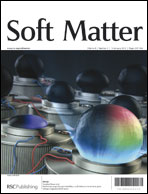Biofunctionalization of free-standing porous silicon films for self-assembly of photonic devices
Abstract
Here we test chemical strategies for the fabrication of free-standing porous silicon thin films that are covalently modified on one of their faces with biorecognition elements to guide the vertical self-assembly of optical structures. Chemical modification viahydrosilylation of


 Please wait while we load your content...
Please wait while we load your content...